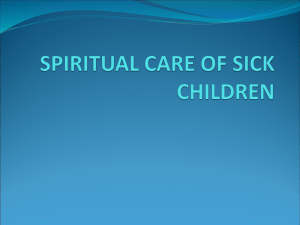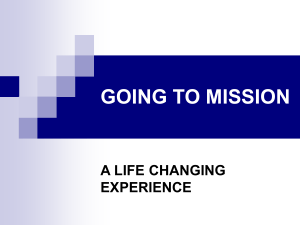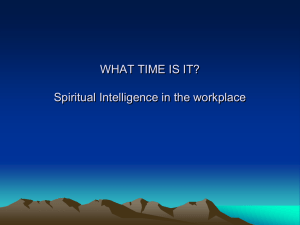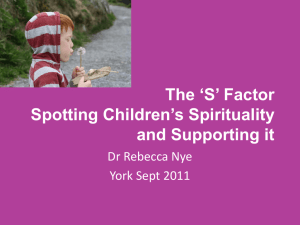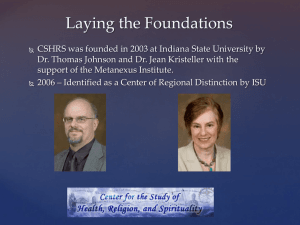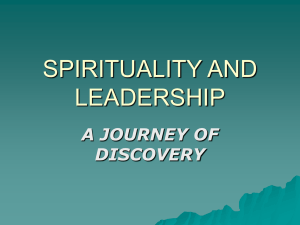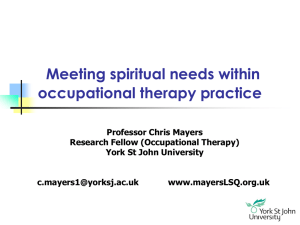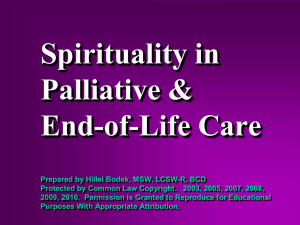Grief, Culture and Spirituality A Framework for Dealing With Diversity
advertisement
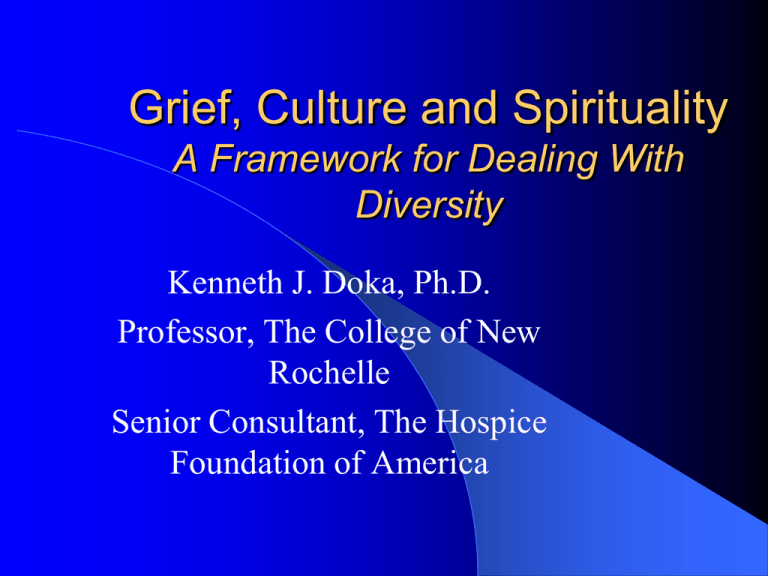
Grief, Culture and Spirituality A Framework for Dealing With Diversity Kenneth J. Doka, Ph.D. Professor, The College of New Rochelle Senior Consultant, The Hospice Foundation of America Goals Explore the nature of culture Discuss the ways that culture influences grief and end-of-life decisions Develop culturally sensitive interventions The Growth of Cultural Diversity in the United States Sources of New Immigration Differential Birth Rates Increasing Racial and Ethnic Diversity The Growth of Non-Western Religions Culture and End of Life Care The Spirit Catches You and You Fall Down Fadiman’s book offers a powerful story of mutual cultural misunderstandings and their impact on care Cultural Awareness Less a body of knowledge than a spirit of inquiry Cultural Do’s and Don’t’s Don’t Do! Social Constructivism (Rosenblatt) There are no universals in grief The only similarity is that “death may be difficult for everyone” Each society constructs its own way to understand grief and mourning Counseling the culturally diverse is simply good counseling Culture is a way of life Culture Can Be Defined by Many Ways Race and Ethnicity Social Class Spirituality Illustration: Ethnicity and Social Class Milton Gordon’s concept of ethclass Social Class – The Hidden Distinction The Myth of the Middle Class Class in America Implications for School and Programs (Photos) Culture Can Also be Defined by: Geography Shared Lifestyle Illustration: Shared Life Style Gay and Lesbian Subcultures Homophobia, trust and healthcare Intimate networks and support Disenfranchised grief Spirituality as a Source of Diversity A Transcendental Belief System Spirituality and Medicine Hippocrates “Prayer indeed is good but while calling on the gods, a man should lend himself a hand” “It is more important to know what sort of a person has a disease than to know what sort of disease a person has.” “Spirituality” (Miller,1994) Spirituality relates to our souls It involves the deep inner essence of who we are It is an openness to the possibility that the soul within each of us is related to the Soul of all that is Spirituality is what happens to us that is so memorable we cannot forget it, and yet we find it difficult to talk about because words fail to describe it Spirituality is the act of looking for meaning in the deepest sense, and looking for it in a way that is authentically ours “Religion” (Miller,1994) Now religion, on the other hand works in a different way In fact, if you take the word back to its origins, “religion” means “ that which binds together” “that which ties things into a package”. Religion has to do with collecting, solidifying, and consolidating Religion say, “Here are special words meant to be passed on. Take them to heart.” Religion says, “Here are a set of coherent beliefs. Take them as your own.” Religion says, “Here are people to revere and historical events for you to recall. Remember them” Religion says, “Here are ways to act when you come together as a group, and here are ways to behave when you are apart.” Spirituality is Eclectic Spirituality is Influenced by Culture Spirituality is Affected by Development Spirituality can both facilitate and complicate adapting to illness and loss Role of Spirituality and Religion Providing Meaning Allowing Connection Reinforcing Self-Esteem Reinforcing Positive Health Habits Offering Social Support Enhancing the Immune System Renewing a Sense of Control Renewing a Sense of Control Interpretive Control Predictive Control Vicarious Control Spiritual Issues Can Be Manifest in: Reactions to the illness End-of-life and other ethical decisions – Prigerson et al (2009) found religious people more likely to take aggressive actions at end-of-life perhaps through belief in miracles, might see DNR as thwarting the gift of life, or see value in suffering Spiritual tasks at each phase of illness The Critical Importance of Spiritual Assessment Spiritual Interventions Meaning Making Strategies – Reminiscence – Dignity Enhancement Therapy Utilizing Spiritual Strengths – Beliefs – Spiritual Practices – Faith Communities (the A List) – Ritual Spiritual Coping Hymns were often a coping strategy for older African-Americans – assisting them in dealing with stressful life events Counselors should consider using them in interventions Hamilton, et al, 2013 Spiritual CounterTransference Spiritual transference can occur when you impose your spiritual issues or practices on others (example – forgiveness) Attempt to proselytize The client’s spiritual struggles raise spiritual issues for you as well We can assist persons When we become comfortable with our own spirituality and respectful of other’s spirituality Faith as Destructive Sometimes spiritual beliefs can be a source of tension or conflict --perhaps creating family divisions People who believe the disease is a divine punishment may not adhere to treatment regimens In other cases beliefs may cause distress (e.g. suicide, homosexuality etc.) The Challenge of Multiple Cultural Identities Race Ethnicity Class Gender Sexual Identity The Role of Cultural Assessment Simply put, No case should ever be presented without an identification and analysis of cultural factors Culture as a continuum We are all cultural creatures The Culture of Counseling Sue & Sue Counselor Values and Beliefs – Affect and self-disclosure – Individualism – Nondirective – Linear, not holistic Counselor Practices and Interventions Counseling the Culturally Diverse Affects Relationships Assessments Interventions Cultural Differences Can Create Barriers to Mutual Understanding Class differences Language differences Counseling culture as poor match Worldview differences Spirituality Health Professionals need to ... Gain knowledge about patient’s culture Understand that their own cultural views are just “one” way to look at reality Develop communication skills that allow for nonjudgmental exchange of values in problem solving Culture affects the ways we look at dying, death, loss and grief Each culture views death differently and has its own strengths and weaknesses A paradigm Culture as facilitating and complicating responses to dying, death, grief, and loss Every culture approaches dying differently Trust Open communication vs. protectiveness Access to care Treatment preferences – including hospice Advance care planning Disclosure and Communication The dilemma between policy and ethical mandates vs. patient wishes, family concerns and culture Truth-telling vs. Truth-offering “the Right of Refusal” The Influence of Culture African-American Responses to LifeThreatening Illness Values born in the struggle with adversity and racism Independence Survival Spirituality Assist adaptation to lifethreatening illness (Becker & Newsom, 2005) Langston Hughes’ Mother to Son Well son, I’ll tell you Life for me ain’t been no crystal stair. It’s had tacks in it, and splinters, And boards torn up And places with no carpet on the floor Bare. But all the time I’se been a-climbin’ on, And reachin’ landin’s And sometimes goin’ in the dark Where there ain’t been no light. So boy, don’t you turn back. Don’t you set down on the steps “Cause you find it kinda hard. Don't you fall now – For I’se still goin, honey, I’se still climbin And life for me ain’t been no crystal stair The Influence of Culture African-American Responses to LifeThreatening Illness Yet, these same values can discourage utilization of hospice; discourage advanced directives, and impair adaptation in the terminal phase. African-Americans Factors in Lower Hospice Utilization Cultural Mistrust, the cessation of curative medical care, and hospice Suffering as spiritually meaningful Spirituality and hope Survival as value Need for information A Reminder: Cultural Caveats The Sociological Fallacy in interpreting research Cultural Competence + Cultural Humility = Cultural Curiosity Ask, do not assume What do I need to know about you (or your culture, your background) to serve you best? Opening a dialogue Cultural Competency Cultural Awareness – appreciating diversity Cultural Knowledge Cultural Skill Cultural Encounters – seeking experience based on mutual learning Cultural Curiosity – open to ongoing learning Areas of Cultural Conflict Historical Mistrust Interpretation of Disability – some cultures may interpret disabilities as spiritual punishments or rewards Locus of Decision-Making Communication Styles (including nonverbal) Cultural Incompatibility of Explanatory Models of Disease or Treatment (be open to incorporating folk treatments as possible complements) Disease without Illness – some symptom less disease such as hypertension may not be recognized Cultural Sensitivity Guidelines LEARN Listen to the patient’s perception of the problem Explain your perceptions and treatment strategy Acknowledge differences between perceptions Recommend treatment while remembering patient’s parameters Negotiate agreement Cultural Sensitivity Do not make assumptions Question patients about their beliefs Do not discount patient beliefs Use indirect strategies Many patients have told me the do _____ or visit _____. Do you? Incorporate folk beliefs Be sensitive to cultural taboos on information or on decision-making Culture and Grief Grief and Culture Attachment – Blauner, Freud, Kastenbaum on death rates, social structure, and attachment Expression Adaptation Styles of Grief – Instrumental vs. Intuitive Culture and Funerals Customs and rituals Expressions of support Access and availability of formal support Cultural Perspective Cultural Strengths vs. Limitations Illustration: Death in the Arctic Death in the Arctic Strengths Strong Community Ties Flexible Family Structures Powerful Rituals Strong Spirituality Death in the Arctic: Limitations High rates of chemical coping High incidence of traumatic death Disenfranchisement of certain losses (I.e. – missing) The Key – A Spirit Mutual Respect and Learning How to Begin? Begin with – ourselves Assessing our own culture, our beliefs, attitudes, values and experiences Guidelines for Sensitive Practice Do not assume Identity more crucial for non-dominant groups Maintain an open, nonjudgmental attitude Use open-ended questions Use gender neutral language Use sensitivity in language Listen and ask, rather than assume selfidentification Remember cohort differences Be eclectic yet experimental and evidenced-based Levels of Inter-Cultural Communication Verbal Non-verbal Paraverbal What are the characteristics of an effective counselor? Skilled and knowledgeable Enlightened ignorance – openness What do I need to know about your culture to be effective? Reflective Self-awareness What are the characteristics of an effective counselor (2)? Learning about the cultures you deal with regularly Observations and cultural informants Research and reading The value of ethnic newspapers, magazines and other media Counseling the Culturally Diverse The Value of Eclectic Approaches Practice Handling challenges and recovery skills Interventions Utilize Beliefs Utilize and Cultivate Community Resources (including faith community) Utilize Culturally Appropriate Interventions Illustration: Using Cultural Practices A Native-American Men’s Support Group in a Sweat Lodge In a trip to Alaska, the Inupiaq – a NativeAmerican Group held a men's grief support group in a sweat-lodge Linking the activity with a traditional way that men found healing and support The Value of Expressive Approaches Bridge to culture Natural Reflective Cathartic Projective The Power of Ritual Liminal Bridge to spirituality and culture Meaning to moment A Multicultural Perspective Will Teach Us What is grief? What does loss mean? What can we learn? – Klass – Continuing Bonds


